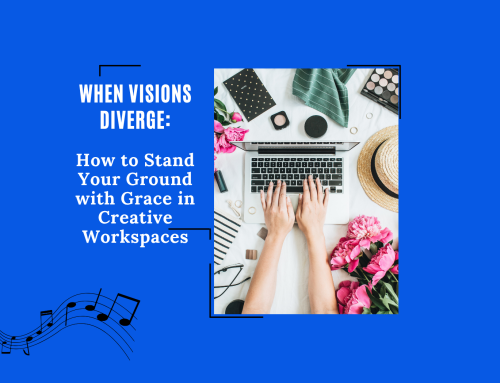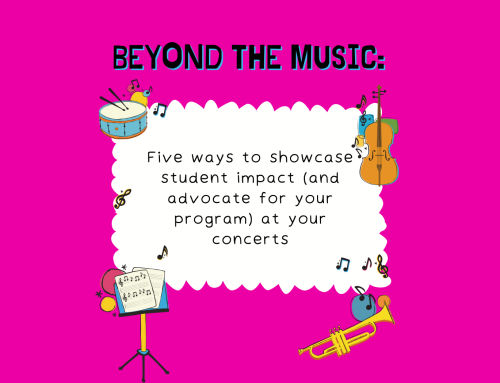Last night, our music department premiered a virtual concert on YouTube. It consisted of virtual performances, testimonials from students, and individual performances. When the show ended, I received an email from one of my administrators. He shared his gratitude for our students and their work and reminded us that this is why we do what we do: to connect and to celebrate.
What was shared last night was not new or surprising to us as music teachers. We know that our students are composing, writing songs, and practicing challenging repertoire. We know that there are strong feelings about the music department that they express to us (in person or writing). We know that what we do matters. But, how do we share that with the rest of our community?
What we (our music department) did was this: we showed evidence of musical and social-emotional outcomes of the past two months while engaging in distance learning.
Through curating and combining words and performances, we effectively told the story of our music program. We shared what we are doing, how we did it, and how it impacted our students.
We told a data story.
What are data and why does it matter
Right now, many music teachers are in a similar position as my colleagues and myself. After being away from our students for two months due to the COVID-19 global pandemic, we are facing an uncertain future. The fall of 2020 is looking grim and educational cuts will happen. The prospect of face-to-face instruction is looking unlikely for many, and our profession will be called upon to justify our place in the educational offerings for students.
So, what can we do?
Last week, I had the privilege of speaking with Victoria Boler about this very topic. The content in this blog stems from a conversation we recorded on data and how it can be identified, collected, and utilized for teaching and advocacy. (You can check out our full conversation in the YouTube video below.)
First of all, “data” has a strong connotation for many. In conducting an informal poll in social media, it was evident that we all approach data from a unique lens. Some view it as complex calculations only to be used and analyzed by statisticians. Others have experienced collecting data in their classroom and are comfortable using it to share the story of their program.
For Victoria, collecting data in her classroom (through observations, words, and performances) helped her reframe the problems she was facing and design better solutions.
For me, it has meant that I can turn my “what, where, how, and why” questions into answers…answers that lead to actionable steps for my students and my community.
So, what are data?
In our case, data are evidence of what we do, how we do it, and how it informs the future of our program or classroom. And, this evidence can be valuable as we move forward and make sense of the learning that has occurred over the past few months.
But, more importantly, if we start getting in the habit of collecting and making sense of data in our classrooms, we will be better teachers! And, we can meet our students’ needs better because we will be able to know if what we’re doing is effective in achieving our overarching goals.
What story will we tell?
I can’t think about this topic without hearing the melody of We Tell the Story from the musical, Once on this Island. In this musical, community members collectively tell the story of a girl named Ti Moune to inform the collective narrative that will shape the future of their people.
Our music program story will inform the collective narrative about our program. It will provide insight and application to administration, parents, and community members.
The data we collect will ultimately tell our story. However, we have the unique position of deciding how to shape the story.
Perhaps you collected data on students’ ability to perform a steady beat to a simple folk song after a specific type of instruction. This data could be valuable for you in knowing how to plan for similar activities and whether or not they are successful. However, this data may not matter to your community members.
So, knowing the values of your community is essential for understanding what story to tell.
How do you know the values of your parents, administrators, and community members? You ask. You look for evidence, and you find out what matters most to them. Then, you craft research questions to focus your efforts on those specifics areas. You find and collect the data, and you compile it to tell a story.
You tell a story using words or numbers. You use student voices; you use reflections from parents and community members. You demonstrate what you have been doing and how you have been doing it.
For example, I know that my district cares deeply about the emotional wellbeing of students. My administrators see this as a top priority during our school’s shutdown. I know that they care less about “how good” our ensembles sound and how our students are meeting musical goals that are shaped by standards and objectives. Because of this, my colleagues and I wanted our music program story (our spring concert) to provide evidence for how music-making has benefited our students’ overall wellbeing. We shared evidence of the positive benefits of music participation, mostly through a section of testimonials. In these short video clips, students responded to the prompt, “what does participation in a music program mean to you?” And, this was the exact outcome that my principal mentioned in his email.
He saw the evidence of what we’ve been doing and how we’ve been doing it and encouraged us in our program’s value within the broader school community.
Now, I have this data. And, I can continue to use it in advocacy efforts for the future of our program in the fall. This is the story we tell.
I’m overwhelmed and don’t know where to start.
Let’s start here:
- What are your main goals for students?
- What is the language surrounding your goals (objectives, standards), and what are the values of your program?
- What are you doing to show evidence that your students are meeting goals/objectives?
- In the absence of public performance, how can you show your community what your students are doing?
- What sorts of questions do you have about your classroom, whether virtual or physical?
The good news is that many of us have been collecting data for months! With the move to remote instruction, much of our students’ performances, stories, responses, and work has been gathered via a learning management system or through programs such as google classroom.
The other piece of good news is that Victoria and I are releasing a guide that can serve as a springboard for collecting and crafting your music program story through the data you collect.
We have done all of the hard work for you- like email templates, google forms, and tips for putting your story together and using it for advocacy. What’s missing is your unique story that shares how you have met students in remarkable ways during this unprecedented time.
We need to all remember that this is not an individual mission. We, as a profession, are in this together. The more we show what we do, why we do it, and how we do it, the more we make a case for the importance of music education everywhere, not just in our classrooms.




Leave A Comment